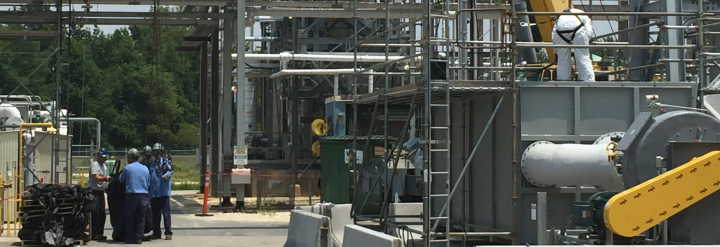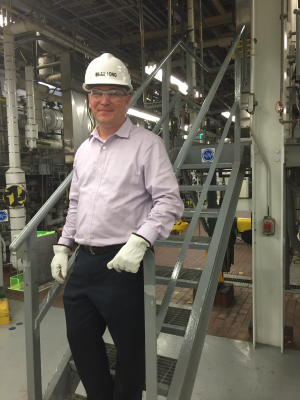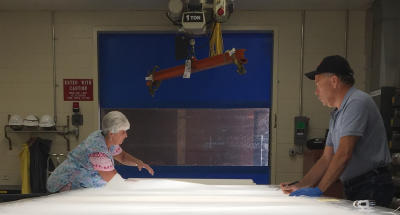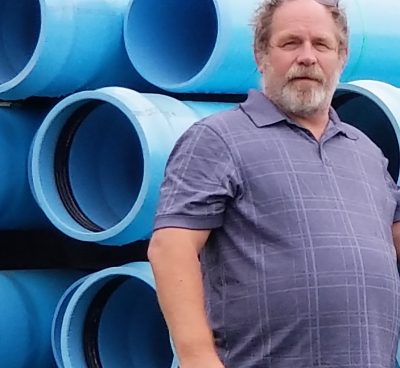
Brian D. Long cemented a reputation early in his career as a go-to guy for tough jobs.
It’s a quality worth mentioning in a LinkedIn profile, where Long writes of having taken on a number of “’fix it’ type of assignments.”
Supporter Spotlight
Asked about the reference, he explained: “I would go into a plant and they’d say, ‘We’d like you to run this area, but we have this safety issue or this productivity issue.’”

So last year as Chemours cast about for someone to pilot a particularly thorny “fix it” assignment — stepping into the eye of the regulatory, legal and community-relations storm centered on its fluorochemical operations at the Fayetteville Works — it looked to its plant in Louisville, Kentucky, then in the hands of 46-year-old Long.
Nearly six months into his new posting, Long already can point to a number of significant changes. He’s overseen the first steps in a project the company says has ratcheted down its fluorochemical emissions and eventually will winnow it to no more than one percent of 2017 levels. He’s turned away from a public relations strategy based largely on silence, instead holding public meetings, talking with journalists and discussing the company’s plans.
The tasks ahead, though, are daunting. State regulators have threatened to ask a court to impose an emissions-reduction schedule Chemours insists can be met only by shutting down. Meanwhile, many of the plant’s neighbors, including hundreds who learned last year the company’s chemicals had contaminated their wells, continue to view the company with deep suspicion.
‘Extremely, Extremely Clean Water’
Late last year, as the state partially suspended Chemours’ National Pollutant Discharge Elimination System, or NPDES, permit, the company capped the pipe channeling its production-related discharge to the Cape Fear River. Since then, on an average day it trucks about 70,000 gallons of wastewater to Texas for disposal.
Supporter Spotlight
Still, GenX and other fluorochemicals from the plant turn up in the Cape Fear, prompting attention to sources such as soil and groundwater at the 2,150-acre site, for decades home to multiple lines of fluorochemical production. Recent tests on soil revealed levels of GenX as high as 32 million parts per trillion, some of which, the company theorizes, washes into storm- and cooling-water channels during heavy rains, so crews began digging it out, removing more than 4,400 cubic feet of soil, almost enough to bury a basketball court beneath a foot of dirt.
That soil contamination likely contributes some of the host of fluorochemicals in water drawn from several monitoring wells at the site. Those wells tap a “perched zone” of water above the water table. The company has pumped about 18,500 gallons of pollutant-laden water from the perched zone, which it believes could be leaking into the lower aquifers that migrate toward the Cape Fear.
As with much of the pollution tied to the Fayetteville Works, including hundreds of tainted private wells, the soil and groundwater contamination resulted largely from Chemours’ air emissions, the target of significant regulatory attention and the company’s recent abatement plans.
“Assuming we have a discharge to the river, we should be able to do that with extremely, extremely clean water — provided we get the permit from the state.”
Brian D. Long, Chemours Plant Manager
In May, Chemours began using carbon adsorption units as a stopgap to whittle down emissions until it can construct the centerpiece of a promised $100 million pollution-reduction project. That keystone, a thermal oxidizer, essentially is a high-end incinerator, using tremendous heat to break the stubborn carbon-fluorine bonds that make fluorochemicals invaluable to industry and intractable in the environment.
In a recent interview at the Fayetteville Works, Long said he is “extremely confident” the carbon-adsorption equipment has trimmed air emissions by 40 percent. Upgrades in October should at least double that reduction.
Once the full system goes online in late 2019 or early 2020, Chemours plans to use it to throttle air emissions and to cut down on liquid waste, which will be vaporized and sent through the thermal oxidizer. In the end, overall fluorochemical pollution will drop by 99 percent compared with 2017 levels, Long said.
“There still might be some (fluorochemicals) in the water that are tough,” Long said. “We will take that water stream through a series of layered emission-reduction technologies such as ion exchange, reverse osmosis and possibly GAC (granular activated carbon) to get all the rest out. Assuming we have a discharge to the river, we should be able to do that with extremely, extremely clean water — provided we get the permit from the state.”
Would this work have happened had researchers’ discovery of GenX and related substances in the Cape Fear River and a downstream public water system not surfaced last summer? “No,” Long said, “not in this manner.”
“Do I think we would have eventually gotten there as a company? Absolutely, because I know the kind of chemistry company that (Chemours CEO) Mark Vergnano wants to run and he is running and will be running.”
A ‘One-Sided and Inaccurate’ Narrative
Regaining his company’s discharge privileges is far from Long’s most immediate regulatory challenge. He also must reconcile Chemours’ schedule for its emissions-reduction project with the far tighter one threatened by the North Carolina Department of Environmental Quality. DEQ is considering asking a Bladen County Superior Court judge to order a 97 percent emissions reduction by Aug. 31. Chemours hopes to achieve 80 percent by October.

In response, Chemours filed a “status report” with the court, in part to counter DEQ’s “one-sided and inaccurate factual and legal narrative.” DEQ’s “97% interim demand is essentially a demand that Chemours do either what is not technologically possible at this point or shut the Fayetteville Works facility,” the company wrote.
Does Long think Chemours was being treated unfairly, maybe singled out? He at first seemed reluctant to respond, then decided differently: “I don’t know of any other company in the state that is being asked to do the things that we’re being asked to do.”
DEQ spokeswoman Megan S. Thorpe declined to say whether the state would stick with its schedule, citing pending litigation.
“We are carefully considering public comment on the draft order now,” Thorpe said.
‘A Bit of a Deficit’ in Trust
Those comments, including emails from about 100 people, largely express support for DEQ’s proposals or urge stricter action. Many also testify to the lack of faith many residents have in Chemours and, sometimes, in their government.
“This is the first year I have had good students explain that their conservation efforts and acts of good environmental stewardship didn’t matter because the government allowed companies to contaminate our water and land anyway.”
LaDonna Coates, Bladen County science teacher
LaDonna Coates, who described herself as a Bladen County science teacher, wrote: “This is the first year I have had good students explain that their conservation efforts and acts of good environmental stewardship didn’t matter because the government allowed companies to contaminate our water and land anyway.
“These were students that couldn’t use the well water on their property due to extreme levels of GenX, and then had the county explain they wouldn’t run water lines to the northern part of the county due to cost.
“My students are smart, and this year taught them that government doesn’t care about people, only money, and companies are allowed to ruin water and land, so why does it matter if they try to conserve water or reduce litter?”
Long acknowledged Chemours’ relationship with the community is “in a bit of a deficit.” He said he hopes the company’s pollution-abatement efforts can change that, but he’s also trying a different public-relations approach. Until early this year, Chemours typically offered terse or no comments on important developments. An empty seat served to represent it at several public meetings.
By reversing that public-facing opacity, Long seeks to rehabilitate the company’s relationship with its neighbors. It’s a strategy he said has been welcomed by the 400 employees and contractors working in Chemours’ facilities.
“They go to church with people who are concerned. They live in the communities with people who are concerned. And they’re neighbors,” Long said. “I’m sure they get asked some of the same hard questions that I get asked. I’m sure that for a period of time they were frustrated because we weren’t talking. And I know now that they’re very happy that we’re in an outreach position where we’re going out and getting into the community.
“My goal here is that people just listen to us and watch us. And then decide whether they can trust us. Trust is not something you can command. It’s not an entitlement. It’s something that has to be earned over time.”
‘I Will Never Trust Chemours’
Long took his most significant image-building step in June, inviting residents to a “town hall” in St. Pauls. No similar events are scheduled, though Chemours may hold others, including in communities downstream where GenX and other substances turned up in public water systems serving hundreds of thousands of people.
In Long’s view, the St. Pauls meeting “went well. It was the first time as a company that we were really in front of our community, very locally. We didn’t have all the answers to all the questions, but it’s important to start a dialogue and it’s important to listen, so we had some takeaways from that town hall.
“It’s very clear to me there were a lot of questions around the GAC units,” he said, referring to the granular activated carbon filters being tested at a handful of contaminated private wells. “There were questions around the pilot studies and questions around ‘when can we have ours?’ So to me, one of the things that’s really important for those homeowners that have wells that are greater than 140 parts per trillion of GenX is that we figure out how to get those units there.”
In July, just a few days after this interview, the company announced it was opening the GAC filter program to any owner of a well testing above the state’s 140 ppt health goal.
DEQ officials, however, told residents it had not OK’d that expansion and cautioned that it “does not consider point-of-entry filtration units like GAC filters a long-term solution to the GenX problems in the Fayetteville area.”
Ultimately, the state wants Chemours to give residents the option of connecting to municipal lines. Chemours says that’s too expensive for most well owners.

Harvey Trutenko was among about 200 people who in June traveled to Faith Tabernacle Christian Center in St. Pauls for the town hall. To enter, he and others submitted to bag searches and metal-detector sweeps for weapons.
“I was expecting to see that,” Trutenko said. “Based on all the other meetings that we’ve been to, people are pretty upset. I figured when Chemours showed up to a meeting finally there would be some kind of security.
“I wasn’t expecting them to be escorting people out for just asking a simple question.” Reportedly, two people considered disruptive by organizers were ejected before the meeting ended.
“That meeting was kind of a joke,” said Trutenko, a social studies teacher at Luther Nick Jeralds Middle School in Fayetteville. “Basically, they tried to pacify us, telling us everything was going to be OK. I think the answers were basically CYA (cover your ass) on Chemours’ part. They didn’t want to admit any guilt on anything.”
In June Trutenko and his wife abandoned their house in the Point East neighborhood, about a mile from the Fayetteville Works. Tests show GenX in his well at about 170 ppt, he said, and he tired of worrying about what comes out of his taps and waiting for a fix more permanent than the bottled water Chemours has offered.
“We’ve invested basically everything we have into that house so that we can sell that house so that we could have our retirement,” he said. “Now the house is basically worthless. I don’t think anybody would be interested in buying the property.
“I personally will never trust Chemours, just because of their history.”
‘Operate Safely and Take Responsibility’
Another Point East homeowner, Mike Watters, has thrown himself into trying to understand the issue. He participates in the well-filter pilot study, works with scientists studying potential fluorochemical contamination in vegetables and keeps in touch with neighbors. Recently, Watters gathered a few dozen signatures on comments submitted to the state urging, among other things, that Chemours be required to provide municipal water to owners of wells where any amounts of GenX and other fluorochemicals were detected, not just those above 140 ppt.

“I’ve talked to about 600 people. I only found two people who, while they want municipal water, just don’t want PWC water,” Watters said, referring to Fayetteville Public Works Commission, a local water utility.
Both Watters and Trutenko are among several residents who have sued Chemours over contamination on their properties. The company faces a slew of other civil actions from residents, environmental groups, utilities and governments, along with a federal criminal investigation.
For his part, Watters said he thinks the state should let Chemours to proceed with its proposed pollution-abatement schedule.
“I think we need to give them time to get the full implementation of the scrubbers,” he said. “That’s not stuff that you just pull off the shelf. I do not think that plant will ever shut down nor do I expect it to. I expect them to operate safely and take responsibility for what they did.”







